Screening programmes: a short guide. Increase effectiveness, maximize benefits and minimize harm (2020)

Download
2020, iiiv + 59 pages
ISBN 978 92 890 5478 2
This publication is only available online.
The purpose of screening is to identify people in an apparently healthy population who are at higher risk of a health problem or a condition, so that an early treatment or inter¬vention can be offered and thereby reduce the incidence and/or mortality of the health problem or condition within the population. There appears to be a growing trend in the WHO European Region towards more screening for noncommunicable diseases and health checks. However, in too many cases, a clear evidence base for effectiveness is missing. Policy-makers, health professionals and the public often seem unaware of the potential harm of screening, its cost and burden on the health system and the need for strong quality assurance. This guide is designed for policy-makers and public health leads involved in planning, designing and implementing screening programmes in the WHO European Region. It describes various aspects policy-makers should consider before starting, continuing or stopping a screening programme and the operational, monitoring and evaluation aspects of implementation. This guide forms part of WHO’s efforts to increase the effectiveness of screening programmes within the Region, maxi¬mizing benefits and minimizing harm.



